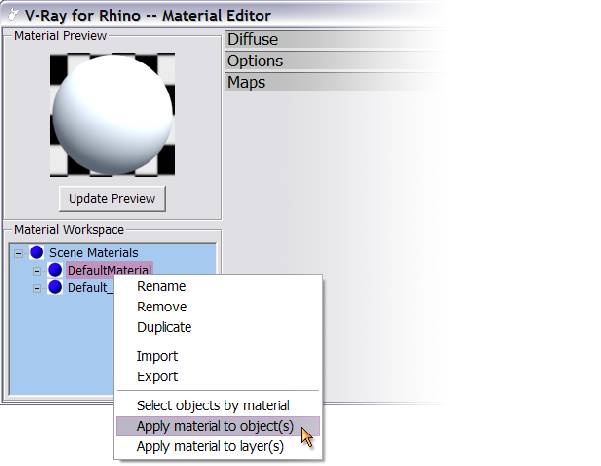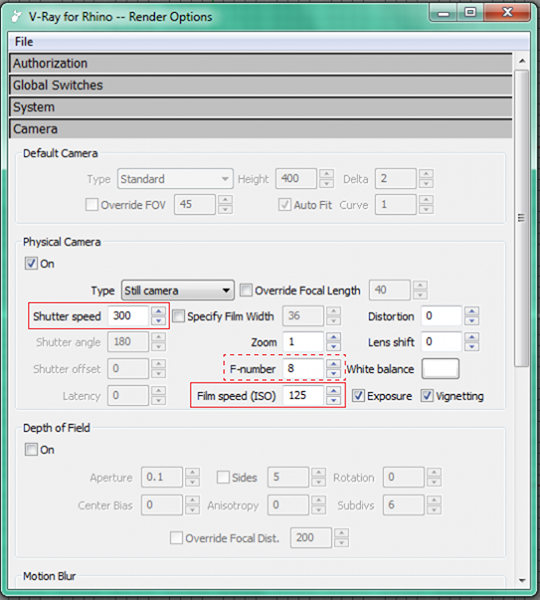| Week 09 - Representing Material | |
|---|---|
| Course | Arch 100a |
| Date | 2013/10/25 |
| Learning Objectives | This class will address material representation in digital models. Using examples of digital perspectival renderings, the merits and demerits of digital material representation will be explored. Students will learn how to use the material editor in V-Ray to adjust material color and reflectivity, assign materials, as well as create their own materials. Building upon prior introductions to V-Ray, the principles behind V-Ray’s physical camera will be further discussed. |
| Agenda |
|
| Uses Tool(s) | VRay , Rhinoceros |
Digital Representations of Material
Last week we discussed perspective as an representational technique and learned how to adjust and set the Camera in V-Ray. This week we'll build upon those concepts and discuss rendered architectural perspectives. More specifically, we'll learn how to use material mapping in V-Ray to further describe design intent and detail in our architectural designs.
V-Ray is a powerful rendering engine that can achieve very accurate and detailed material representations, yet this should be used with consideration and care. While the capability supports a near photo-realistic approach to representation, in which almost every material and surface are explicitly rendered, this strategy doesn't necessarily more effectively represent one's design. In fact, an exhaustive description of the project can often muddy the design intent. Thus, material representation should be employed very selectively, as a means to built and support a tight and cohesive argument for your project.
To begin, we will look at a few examples of ways in which architectural practices have used the rendered perspective to develop and enrich their design language, as well as consider ways in which the rendered perspective can serve as an active design tool, not simply a final representation document.
V-Ray and Materials
Material Property Basics
Using V-Ray's Material Editor, materials can be attributed to both layers as well as individual objects in your Rhino model. Materials can be made up of different layer attributes (such as texture, transparency, bumps, etc) in effort to not read more than a flat texture mapping. Sometimes these layers depend on a value (such as intensity or a percentage of transparency) while other times they come from a gray-scale image.
About V-Ray Material Layers
Each V-Ray Material typically consists of the layers discussed below. A new default V-Ray material will only consist of a Diffuse and Maps layer, more complex materials might contain layers that set reflectivity or brightness such as Emissive or Reflection layers.
The "Update Preview" button is useful to give you a rough idea of the material settings.
DIFFUSE LAYERS
This is the standard, most basic layer within a V-Ray material. It references color, as well as any image texture mapping, and transparency.
- Diffuse Color
- Change the overall color of an object by clicking the square and selecting a color OR texture map an image onto the an object by selecting the "m" box. A lowercase "m" indicates that no file has been mapped, while an uppercase "M" indicates that a texture file has been linked.
- Transparency
- Change the overall transparency of an object OR map a transparency pattern onto the object. Black is completely opaque and white is completely transparent .
MAPS
- Bump Map
- Changes the way the surface texture appears three-dimensionally, changes the surface normal to create the illusion of surface detail.
- Displacement Map
- Actually changes the way the surface appears three-dimensionally (such as outlines and edges of the surface) to represent a textured surface
REFLECTION LAYERS
- Reflection
- Adds reflection to the object. White is completely reflective (like a mirror) and black is non-reflective . By Default the reflection layer has a fresnel map which varies the amount of reflection based on the viewing angle (notice the capital M next to the Reflection layer). To make more reflective, increase the Fresnel IOR.
More information on Reflection Layers can be found here
EMISSIVE LAYERS
- Emissive
- Changes the object to become an emitter. Change the intensity to affect how bright the light source becomes. Can change color, intensity, and transparency.
More information on Emissive Layers can be found here
REFRACTION LAYERS
- Transparency
- The darker the Refraction Transparency, the more the material references the edges of the objection (although transparent).
- Fog Color
- Use this rather than Refraction Color to change the color of the transparent material. Fog color is dependent upon the multiplier, the color and the size of the object. Be sure to pick a color that is slightly less saturated that you desire.
- Glossiness
- Helps change the frostiness of the transparent material. The lower the number, the more blurry the refraction.
- IOR (Index of Refraction)
- Essentially the degree to which the angle of light entering the material changes upon exiting the material. Calculated the light refracted from the tranparent object. Lowering the IOR decreases the intensity of the Refraction settings.
More information on the Refraction Layer can be found here
A helpful discussion of the difference between Reflection and Refraction can be found here
Adding Materials to your Rhino Model
There are two ways to access the Material Editor in V-Ray: from the toolbar and from the Object Properties panel.
- Using the V-Ray toolbar, left click on the icon that looks like a tag with the letter "M" on it.
- Using the Object Properties panel, select the object(s) to create a V-Ray material for. Use the Properties command and select Material from the drop-down menu. Assign by Plug-in and then click Create.
Loading .vismat Materials
The .vismat file type is specific to V-ray for Rhino and loads directly into the Material Editor by right clicking on Scene Material and selecting "Import new material" and loading your desired .vismat file directly into the Material Editor.
A number of pre-made .vismat files can be found from the sources below or through a direct Google search (ie "Concrete .vismat"). V-Ray also comes with a number of pre-loaded materials which can typically found in this file path: Program Data > ASGvis > Materials
Ready-made V-Ray Materials
- V-Ray Materials
- Collection of user-uploaded V-Ray materials. Account Registration required.
- Flying Architecture
- This website has some good materials for free download, such as concrete, wood and glass. Be sure to save the whole unzipped folder in an easy to find location.
Creating Custom Composite Materials
Often we are unable to find a pre-made .vismat material that fits what we have in mind, in which case a custom material can be created by following this workflow .
Hi-Res Textures for Creating your own Materials
- Render Textures
- A great collection of texture map ensembles. Each material consists of different matching material maps (such as diffuse, bump, displacement, transparency). This is a good place to go if you want to create your own material from scratch.
- CGTextures
- Vast library of high-resolution textures for download. Account registration required.
- Maya NG's Textures
- Over 4250 free, high-resolution textures. Limited to 20 downloads per day.
Assigning Materials
Once you have your desired materials either loaded or created in the Material Editor, it is time to assign the materials to the appropriate model geometry.
Materials can be applied in two ways: from within the V-Ray Material Editor, or within Rhino's Properties tab.
In the V-Ray Material editor, right click on the material name, and then click on either "Apply material to layer(s)" or "Apply material to object(s)".
Typically it's recommended to apply materials to Layers rather than directly to objects as this proves much easier to manage. Once you are starting to represent your project, this process can be facilitated by grouping model elements into their material types, ie Glass, Wood, etc.

To attribute the material to objects or layers in Rhino, select the objects or layers. Then, use the Properties command and select Material from the drop-down menu. Assign the material by Plug-in, and then click Browse to select the desired material.

Adjusting Material Scale and Orientation
Depending on the scale of the model, the way the model was built, and the default settings in V-Ray, the image map and transparency map may not be rendered in V-Ray accurate to the scale of the building in real life. The image map may be enlarged and look stretched out, or the transparency map may not create the right effect because of its size relative to the building.
The test render should reveal whether or not the image map and transparency map are mapping at the right scale.
To adjust material scale and orientation, select the model elements you would like to edit and in the "Properties" tab click "Texture Mapping". Depending on what your model elements are you will either want "Planar" (for flat surfaces) or "Box" (for rectangular or volumetric elements). Then adjust the scale values (under "XYZ size"). Orientation can be adjusted in the "XYZ" rotation values; it is best to start testing with one value first, ie just the X.
Alternatively, material scale can be adjusted natively within the Material Editor, as discussed here .
Even more information on Texture Mapping and dealing with issues of scale and orientation can be found in the
V-Ray for Rhino Manual
All about Texture Mapping in Rhino 5 here
Another helpful discussion of Texture Mapping and scale here
V-Ray's Physical Camera
Rendering is similar to photography in many respects. Generally, after modeling the scene, a point of view is set for the camera. From this point of view, the image will be captured, and the light settings and material settings affect the resulting render.
To produce a more realistic render, check the "On" box under Physical Camera in the Camera settings in the V-Ray Render Options window.
There are settings that are set on a physical camera that can be set for the render. Some of the important settings to pay attention to include:
- Film speed (ISO) : the greater the ISO, the more sensitive to light the camera will be. ie. lower ISO = darker image
- Shutter speed : the greater the shutter speed, the shorter amount of time the shutter will be open. This will result in a darker image because the amount of time that light is allowed to affect the sensor is decreased. The parameter is actually interpreted as 1/x, so entering a value of 300 means the shutter speed will be 1/300th of a second. ie. longer (or lower) shutter speed = brighter image
- For a daylight scene with the sun being the only source of light, your shutter speed value should be around 300-500 (depending on the daytime in the sun settings) and the ISO should be around 100-150 .
- F-number : also known as aperture or f-stop. The smaller the aperture, the larger the lens opening. The aperture combined with the shutter speed are adjusted to control the camera's degree of exposure to light. A lower f-number will make for a brighter image . For simplicity's sake, it will be easiest to limit your adjustments to the shutter speed and ISO, as adjusting the F-number adds another variable to keep track of and, if desired, can affect the image's depth of field. Typically it is best to leave the F-number at 8 .
- Depth of Field : While in a physical camera the F-number or aperture affects the Depth of Field, in V-Ray you must turn on the Depth-of-Field Option to enable the effect. Depth of field (or the focus range) increases with f-number, as illustrated in the image here.
This means that photographs taken with a low f-number will tend to have subjects at one distance in focus, with the rest of the image (nearer and farther elements) out of focus. Think of a Pinhole Camera: small aperture=large depth of field .
For most architectural renderings, the desired effect will typically be for everything to be in the same focal range (ie Depth of Field NOT enabled), but in some specific cases this effect can be employed in order to highlight or accentuate a design argument.
Additional Resources
V-Ray Physical Camera Examples
- Chaosgroup's website which contains a number of examples that graphically illustrate the different settings on the V-Ray Camera
Additional Workflows
- Creating Composite Materials Using Image-Maps in V-Ray
- Using the facade of the de Young Museum as an example, this workflow demonstrates how to use custom-generated image maps to define composite material "layers" in V-Ray. Using the material editor dialog, we will edit the transparency, diffuse, and displacement layers to create the pattern of punches across the material, alter the color using an image map, and simulate the bumps of the material.
- Basic V-Ray Rendering Workflow
- This workflow will showcase the steps necessary to create a basic interior rendering with the V-Ray for Rhino plug in. The workflow will cover basic camera setup, sun and sky, and materials to create a convincing, high quality rendering.
- Rendering with V-Ray
- A pretty thorough introduction to V-Ray. This session page reviews the V-Ray interface, setting up views in the Camera, Basics of Lighting; and an introduction to Materials.
- V-Ray Overview
- Though this workflow doesn't discuss materials in V-Ray, it does have some helpful information on adjusting settings in terms of lighting and rendering options.







